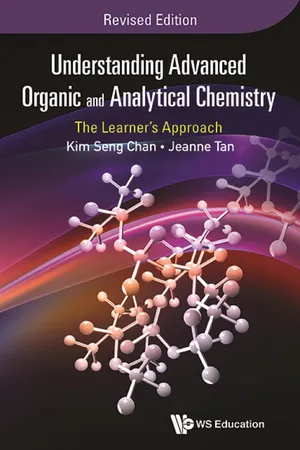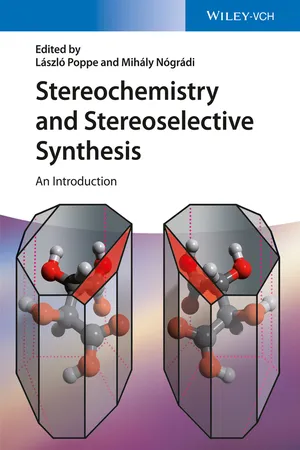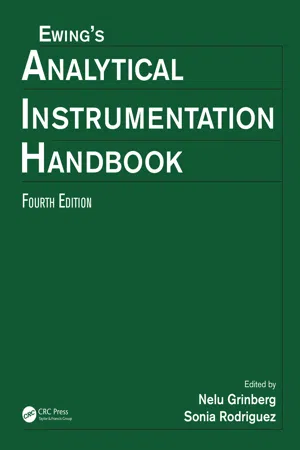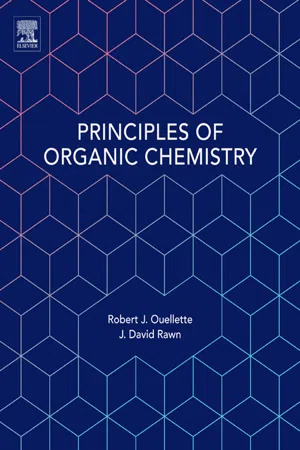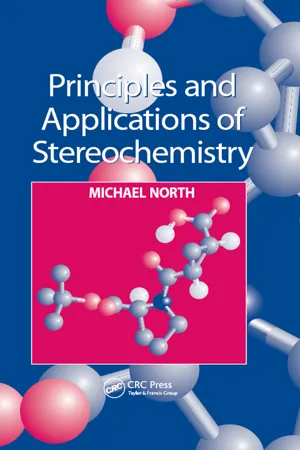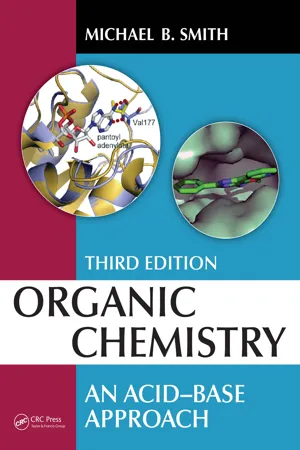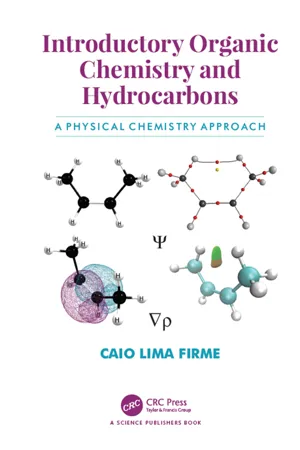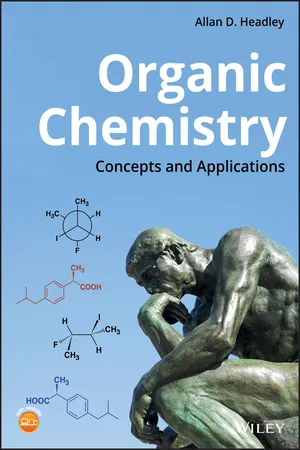Chemistry
Optical Isomerism
Optical isomerism is a type of stereoisomerism where molecules have the same molecular formula and connectivity but differ in the spatial arrangement of their atoms, leading to non-superimposable mirror images. These mirror-image molecules are called enantiomers and exhibit optical activity, meaning they rotate the plane of polarized light. Optical isomerism is important in fields such as pharmaceuticals and biochemistry due to its influence on biological activity.
Written by Perlego with AI-assistance
Related key terms
Related key terms
1 of 4
Related key terms
1 of 3
10 Key excerpts on "Optical Isomerism"
- eBook - ePub
Carbohydrate Chemistry
Fundamentals and Applications
- Raimo Alén(Author)
- 2018(Publication Date)
- WSPC(Publisher)
optical isomers (the phenomenon is called “Optical Isomerism”).Fig. 3.10.When four different substituents (A ≠ B ≠ D ≠ E) bond with the atom C, two stereoisomeric forms are produced that are mirror images of one another. They cannot be superimposable without a rearrangement involving two bonds.The molecular asymmetry described above arises from anasymmetriccarbon atom (such carbon atoms are indicated with an asterisk * when necessary), with four different substituents (atoms or atom groups) bonded to them, which then forms thechiral centerorchirality center(i.e., the center of asymmetry). The structural inequality of these enantiomers that arises from this center of chirality is also easily identified from molecular models; one or several asymmetrical carbon atoms cause almost without exception, among others, the optical activity of carbohydrates. (cf., Chapt. “1. Introduction” ). On the other hand, it should be noted that even though an atom contains asymmetric carbon atoms, it does not necessarily lead to optical activity (cf.,mesoforms, Chapt. “4.2. The Total Number of Stereoisomers” ). In these cases, internal symmetry exists between parts of the molecule, causing the chiral centers to “cancel” each other’s effect.Even though optical activity was first observed in compounds containing asymmetric carbon atoms, it also arises from centers of asymmetry formed by other atoms, such as silicon, nitrogen, phosphorus, and sulfur. Furthermore, optical activity arising from the asymmetry of the molecule is found in certain organic compounds that form rigid structures, either due to saturated bonds (e.g., allene derivatives containing an axis of chirality) or caused by hindered free rotation about a bond (e.g., certain so-called “atropisomers”, such as biphenyl derivatives) (Fig. 3.11 ).Fig. 3.11. - eBook - ePub
Symmetry, Spectroscopy, and Crystallography
The Structural Nexus
- Robert Glaser(Author)
- 2015(Publication Date)
- Wiley-VCH(Publisher)
constitution).5.2 Chiroptical Properties: Circular Birefringence, Optical Rotatory Dispersion, and Circular Dichroism
In spite of loss in rigor, often for heuristic (teaching) purposes, quantum mechanical phenomena are sometimes more easily explained in terms of argumentation drawn from our macro-world as a “first approximation to the real truth.” This is especially beneficial when quantum mechanics are being explained to nonphysicists. We will take such liberties when discussing chiro-optical (chiroptical) properties. Consider an electromagnetic beam to consist of an electric field's oscillating sine-wave plane perpendicular to that of the magnetic field. Sine waves are achiral and may be thought of as horizontal plane projections of either right- or left-handed enantiomorphous in-phase helical chiral-twisted oscillating fields. Note that the projection shadow upon a flat surface of a pair of right- or left-handed in-phase helices is the same identical sine wave. Furthermore, let us consider a photon's path to propagate outward from the source at a particular velocity (ν) on one of the aforementioned helical pathways. What significance does this have? The helix diameter represents the vertical distance between the sine wave's maxima and minima, that is, the sine wave's intensity. Furthermore, the horizontal axial distance between two consecutive coil maxima symbolizes the wavelength. For the sake of argument and heuristic purposes, let us further stipulate that a red-colored dot appears at the same single end of a mixture of parallel enantiomorphous helical pathways. Next, imagine placing the laterally disposed helices in such a manner that their red-colored termini all touch a transparent barrier. When our eyes look through the clear barrier down the non-phase-restricted parallel helices, the red dots will appear to have an infinite number of orientations. One can think of a polarizer - eBook - ePub
Understanding Advanced Organic and Analytical Chemistry
The Learner's ApproachRevised Edition
- Kim Seng Chan, Jeanne Tan;;;(Authors)
- 2016(Publication Date)
- WS EDUCATION(Publisher)
2 BrCl for instance. It is a polar molecule. This means that there is already a non-homogeneous distribution of electron density in the molecule. But if you look at the molecule closely, there is also a plane of symmetry. This means that the plane of symmetry would cut this non-homogeneous distribution of electron density into two parts which are exactly mirror images of each other. Hence, such a molecule would not be optically active. There are molecules that do not possess any chiral centers at all, and yet there is a non-homogeneous distribution of electron cloud with the absence of a plane of symmetry — such molecules are still optically active. One such molecule is the molecule discussed in Question 3 under the My Tutorial section.Q:Is chirality and optical activity synonymous?A:No! Chirality is a molecular property (same for enantiomerism) that is restricted to a particular molecule in consideration whereas optical activity is a BULK property (or macroscopic) of a collection of chiral molecules.Q:So, we cannot say that an enantiomer is an optical isomer?A:Yes, it is inappropriate to do that as enantiomerism is the consideration at the molecular level. You cannot measure the optical activity of a molecule alone. So, you cannot say that a molecule is an optical isomer.Example 2.3: Identify the chiral carbons in the following molecule.Approach: A chiral carbon is bonded to four different atoms or groups of atoms. Look out in a systematic order for the existence of such carbon atoms. Take note of skeletal structures, such as this one here, where C–H bonds are not explicitly shown and a C–C bond is indicated by a “line.” There are a total of three chiral carbons:Sometimes, the differences between the substituents may not be obvious. For instance, moving away from C1 are two similar –CH2 groups, but these are further attached to C atoms with different bonding patterns. Thus, these two substituents are not considered identical. The same goes for the chiral carbon bonded to the Br atom — the difference between two of its substituents only surfaces at the third carbon atom away from the chiral center. Note that the circled C atoms are not chiral as they are sp2 - eBook - ePub
Stereochemistry and Stereoselective Synthesis
An Introduction
- Mihály Nógrádi, László Poppe, József Nagy, Gábor Hornyánszky, Zoltán Boros(Authors)
- 2016(Publication Date)
- Wiley-VCH(Publisher)
isomerism, recommendations of IUPAC rules [2–4] are of not much help either. Consequently, along with explanations, occasionally we recommend definitions at variance with IUPAC recommendations.- Isomerism: relationship between isomers [2–4].
Isomer: one among compounds (or molecular entities) that have identical chemical formulas but can be isolated and exhibit different physical and/or chemical properties.[According to IUPAC recommendations [2–4], an isomer is one of the several species (or molecular entities) that have the same atomic composition (molecular formula) but different line formulae or different stereochemical formulae and hence different physical and/or chemical properties.]
We have to admit that even our proposed concept of isomerism including isolability is not completely unambiguous,11 since the criterion for isolability cannot be defined precisely. Nevertheless, our proposition is nearer to the everyday praxis of organic chemist than the IUPAC recommendations, since when taking them strictly, then labile, but chiral forms of tertiary amines, the tautomeric pair of acetaldehyde and vinyl alcohol, and further even different conformations of n-butane (e.g., its eclipsed and open conformations) should be regarded as isomers.Isomers can arise (taking into account the criterion of isolability) for multiple reasons (Figure 2.6 ). To distinguish the types of isomers different terms are given.Constitutional isomer: one among isomers, that is, molecules that have different constitutions but the same chemical (molecular) formula. In constitutional isomers, the connectedness - Nelu Grinberg, Sonia Rodriguez, Nelu Grinberg, Sonia Rodriguez(Authors)
- 2019(Publication Date)
- CRC Press(Publisher)
Most forms of optical spectroscopy are usually concerned with measurement of the absorption or emission of electromagnetic radiation, the energy of which lies between 10 and 50,000 wavenumbers. Any possible effects associated with the polarization of the electric vectors of the radiant energy are not normally considered during the course of commonly performed experiments. For molecules lacking certain types of molecular symmetry, interactions with polarized radiation are important and can be utilized to study a wide variety of phenomena. Materials are therefore classified as being either isotropic (incapable of influencing the polarization state of light) or anisotropic (having the ability to affect the polarization properties of transmitted light).Molecules for which the mirror images cannot be superimposed are denoted as being dissymmetric or chiral, and these enantiomer structures are capable of being resolved. The fundamental requirement for the existence of molecular dissymmetry is that the molecule cannot possess any improper axes of rotation, the minimal interpretation of which implies additional interaction with light whose electric vectors are circularly polarized. This property manifests itself in an apparent rotation of the plane of linearly polarized light (polarimetry) or in a preferential absorption of either left- or right-circularly polarized light (circular dichroism). Circular dichroism (CD) can be observed in either electronic or vibrational bands. The Raman scattering of a chiral compound can also reflect the optical activity of the molecule. Should the excited state of a compound be both luminescent and chiral, then the property of circularly polarized luminescence can be observed. The circular dichroism of an optically active molecule can be used in conjunction with fluorescence monitoring to provide a differential excitation spectrum (fluorescence-detected circular dichroism).A variety of chiroptical techniques are available, and these can be useful in analytical work. The foremost problem is a determination of the absolute configuration of all dissymmetric atoms within a molecule. Any chiroptical technique can be used to obtain the enantiomeric purity of a given sample, although certain methods have been found to be more useful than others. Questions of optical activity are of extreme importance to the pharmaceutical industry, where an ever-increasing number of drugs that contain chiral substituents are being synthesized. Documentation of the properties of any and all dissymmetric centers is essential to the successful registration of such substances. The entire field of asymmetric chemical synthesis is supported by studies of molecular optical activity.- eBook - ePub
- Robert J. Ouellette, J. David Rawn(Authors)
- 2015(Publication Date)
- Elsevier(Publisher)
6Stereochemistry
6.1 Configuration of Molecules
In Chapters 3 and 4 we considered the structures of geometric isomers, which are one of a general class of stereoisomers. Stereoisomers have the same connectivity—the same sequence of bonded atoms—but different arrangements of the atoms in space. The different three-dimensional arrangements of atoms in space determine their configurations. Geometric isomers have different configurations. The configuration of a molecule plays a major role in its biological properties. Stereoisomers often have entirely different biological properties. Geometric isomers invariably elicit different responses in organisms. For example, bombykol, the sex attractant of the male silk-worm moth, has a (Z)/(E) arrangement about the double bonds at C-10 and C-12. It is 109 to 1013 times more potent than the other three possible geometric isomers. Disparlure, the sex attractant of the female gypsy moth, is biologically active only if the alkyl groups bonded to the three-membered ring are in a cis configuration.Geometric isomerism is only one type of stereoisomerism. Another type of stereoisomerism is the result of the minor image relationships between molecules, the subject of this chapter. These molecules differ in configuration about an sp3 -hybridized, “tetrahedral carbon” atom bearing four different groups of atoms, which is called a stereogenic center. This phenomenon is not as easily visualized as geometric isomers, but its consequences are even more vital to life processes.6.2 Mirror Images and Chirality
The fact that we live in a three-dimensional world has important personal consequences. In the simple act of looking into a mirror, you see someone who does not actually exist—namely, your mirror image. Every object has a mirror image, but this reflected image need not be identical to the actual object. Let’s consider a few common three-dimensional objects. A simple wooden chair looks exactly like its mirror image (Figure 6.1 ). When an object and its mirror image exactly match, we say that they are superimposable. - eBook - ePub
- Michael North(Author)
- 2017(Publication Date)
- Routledge(Publisher)
S stereochemistry) as discussed in section 3.3.The one class of physical techniques that can distinguish between the two enantiomers of a compound are chiroptical techniques, the most common of which is optical rotation. The chiroptical properties of a molecule are determined not just by the bond lengths and angles but also by the sign and magnitude of the torsional angles, the sign of the torsional angles being the one difference between enantiomers (cf. Chapter 1 , section 1.5.1).3.4.1 Optical rotationA light beam can be described by two orthogonal and sinusoidally varying vectors representing the electrical and magnetic components of the wave respectively. When a beam of light passes through a solution of a compound, the electrical and magnetic fields within the light beam will be refracted by the electrons of the solute (and solvent) molecules. If the beam of light is initially plane polarized, i.e. all of the electrical and magnetic vectors are aligned, then the net result of this refraction will be to rotate the plane of the polarization. The direction and magnitude of this rotation will depend upon the orientation of the molecule, and if in a particular orientation a molecule rotates the plane by θ°, then in the mirror image orientation the same molecule will induce a rotation of –θ°.For an achiral solute, as the light beam passes through the solution it will interact with millions of different molecules. For every molecular orientation encountered, the mirror image orientation will also be encountered, so the rotations will cancel out and no net rotation of the plane of polarization will occur. However, in the case of a single enantiomer of a chiral solute, the mirror image orientation cannot be present (if it were, the molecule would be superimposable on its mirror image and so achiral), so the optical rotations do not cancel out and a measurable rotation builds up. This is shown inFigure 3.2 - eBook - ePub
Organic Chemistry
An Acid-Base Approach
- Michael B. Smith(Author)
- 2022(Publication Date)
- CRC Press(Publisher)
Chirality, Enantiomers, and DiastereomersDOI: 10.1201/9781003174929-9The video clips for this chapter are available at: https://routledgetextbooks.com/textbooks/9780367768706/chapter-9.phpThis chapter will focus on a class of isomers that differ only in the spatial arrangement of attached atoms and groups about an atom. When two different molecules have the same atoms, groups, and the same empirical formula, they are isomers. When they have the same points of attachment (the same connectivity), but differ in the spatial arrangement of those groups, they are different molecules known as stereoisomers .To begin this chapter, you should know the following points:- Name organic molecules, based on the nomenclature rules (Sections 4.4,5 and 5.1–5.6).
- The VSEPR model for drawing structures (Section 3.6).
- σ-bonds. (Sections 3.3 and 3.8).
- π-Bonds. (Sections 5.1–5.3).
- Constitutional isomers (Sections 4.2 and 4.4).
- Rotation about covalent single bonds (Section 8.1).
- Conformations of acyclic molecules (Sections 8.1–8.3).
- Conformations of cyclic molecules (Sections 8.5–8.7).
- Physical properties associated with organic compounds (Section 5.8).
9.1 Stereogenic Carbons and Stereoisomers
Defining a Stereogenic CenterA mirror image is defined as an image or object that is identical except that the structure is reversed. A “W” and its mirror image are shown and it is easy to see that one “W” can be placed on the mirror image “W” so they are completely superimposable . In other words, the two images represent one “W,” not two.Since the “W” is symmetrical there is a plane of symmetry as shown. When a sp3 -hybridized carbon has four identical atoms or groups attached the mirror image of that molecule is superimposable. Such a molecule has symmetry and if it is superimposable, it is the same molecule. An example is methane. There is a plane of symmetry that bisects the central carbon and two of the hydrogen atoms, illustrated by the pane through the tetrahedron superimposed on methane in Figure 9.1 - eBook - ePub
Introductory Organic Chemistry and Hydrocarbons
A Physical Chemistry Approach
- Caio Lima Firme(Author)
- 2019(Publication Date)
- CRC Press(Publisher)
Optical stereoisomerism is related to the pair of isomers which have distinguished optical properties (or which are optically active), although any other property is the same for both isomers. Optically active molecules are a pair of molecules which are non-superimposable mirror images and they are called enantiomers, i.e., they are chiral molecules or they have chirality (more details in the next subsection). The enantiomers deviate the polarized light at certain wavelength to opposing directions but same magnitude. This is experimentally observed by the use of polarimeter, which measures the angle of rotation when the polarized light passes through an optically active molecule.Optically active molecules or chiral molecules can have one of the three options: (1) stereogenic/chirality/asymmetric center or stereocenter which is a tetrahedral atom (carbon, nitrogen, silicon, etc.) with four different substituents; (2) axial chirality which is a spatial arrangement involving a set of atoms in one axis that gives rise to a pair of chiral molecules (non-superimposable mirror images); (3) planar chirality which is a pair of chiral molecules having non-coplanar rings which are asymmetric from one another and cannot easily rotate about one another due to a steric hindrance.General cases of axial chirality are substituted allenes or substituted spirobicycloalkanes. In allenes, there are two double bonds in the same sp carbon atom bonded to two sp2 carbon atoms at each side. In order to avoid electronic repulsion of both π bonds in the same plane, there is a right angle between them which makes the substituents in each sp2 carbon atom adopt a right angle with respect to the substituents of the other sp2 carbon atom. If there are, at least, one substituent different from hydrogen in each sp2 carbon atom, there appears chirality in the molecule, e.g., 1,3-dichloro propadiene and 4-chloropenta-2,3-dien-2-ol (Fig. 13.3(A) ) have enantiomerism. As for spirobicycloalkanes, there is one and only one carbon uniting two saturated rings (called spirocarbon). Since the spirocarbon is a tetrahedron, one ring is placed in the plane of the paper and the other ring is placed at a right angle to the plane of the paper. The substituents in each opposing carbon atom with respect to the spirocarbon adopt opposing orientations of the whole ring it belongs in order to respect the fact that in a tetrahedron, two bonds are in the plane and two other bonds are out of the plane. If there are, at least, one substituent different from hydrogen in each of these carbons, there is chirality in the molecule. For example, 2,6-dichloro-spiro[3,3]heptane has enantiomerism (Fig. 13.3(B) - eBook - ePub
Organic Chemistry
Concepts and Applications
- Allan D. Headley(Author)
- 2019(Publication Date)
- Wiley(Publisher)
Figure 5.2 .The molecules shown in Figure 5.2 differ from each other only in the spatial arrangements of the four different groups around the central carbon. This central carbon of compounds that have four different groups is known as a stereogenic carbon. Thus, a stereogenic carbon is a carbon that is bonded to four different groups. An examination of a slightly different molecule, which has the same two atoms or groups bonded to a carbon and two different atoms or groups, gives a totally different outcome, as shown in the molecules in Figure 5.3 .L ‐Alanine and D ‐alanine are different molecules; they are mirror images of each other and are not superimposable on each other.Figure 5.1Nonsuperimposable mirror images, also known as enantiomers.Figure 5.2Superimposable mirror images, or same molecules.Figure 5.3An example of a symmetrical molecule, which is not a stereogenic molecule.Figure 5.4Even though these compounds are mirror images of each other, they are superimposable on each other and hence they are not enantiomers, but instead they are the same molecules. Note that for these molecules there is a plane of reflection through the carbon, chlorine, and fluorine atoms, as shown in Figure 5.4 . That is, the two hydrogen atoms reflect across that plane. Such molecules are referred to as symmetric molecules or have a plane of symmetry. Such molecules are achiral or not stereogenic.5.2.1 Determination of Enantiomerism
The use of an imaginary mirror to assist in the determination of enantiomerism is a very tedious exercise. Some simple observations of the molecules in both examples given above can be made to decide if molecules are stereogenic or not. Molecules that are asymmetric or molecules that do not have a plane of symmetry (as the molecules shown in Figure 5.2 ) are stereogenic and will exhibit enantiomerism. If a molecule has a carbon atom that has four different groups bonded to that carbon, then that molecule is stereogenic. These simple observations will assist in a quick determination of enantiomerism in molecules. Figure 5.5
Index pages curate the most relevant extracts from our library of academic textbooks. They’ve been created using an in-house natural language model (NLM), each adding context and meaning to key research topics.
Explore more topic indexes
Explore more topic indexes
1 of 6
Explore more topic indexes
1 of 4


